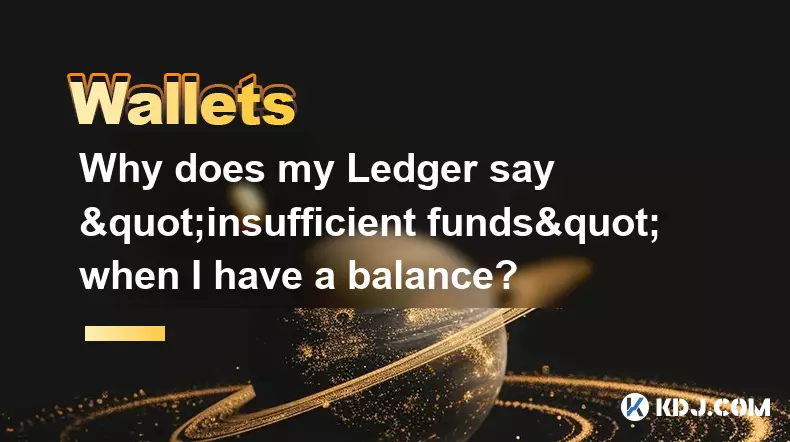-
 bitcoin
bitcoin $109523.663807 USD
-0.13% -
 ethereum
ethereum $4019.526508 USD
2.06% -
 tether
tether $1.000482 USD
0.00% -
 xrp
xrp $2.776815 USD
0.18% -
 bnb
bnb $958.942396 USD
0.12% -
 solana
solana $204.294698 USD
3.84% -
 usd-coin
usd-coin $0.999693 USD
0.00% -
 dogecoin
dogecoin $0.232115 USD
2.09% -
 tron
tron $0.338028 USD
0.84% -
 cardano
cardano $0.790920 USD
1.50% -
 hyperliquid
hyperliquid $44.871443 USD
5.60% -
 ethena-usde
ethena-usde $1.000322 USD
0.04% -
 chainlink
chainlink $21.034165 USD
2.60% -
 avalanche
avalanche $28.794831 USD
-0.54% -
 stellar
stellar $0.360466 USD
1.24%
Why does my Ledger say "insufficient funds" when I have a balance?
Your Ledger may show a balance but block transactions due to pending confirmations, missing gas fees (like ETH for ERC-20 tokens), or network fees exceeding available funds.
Sep 12, 2025 at 04:54 pm

Understanding Wallet Balance Display vs. Spendable Amount
1. The balance shown in your Ledger wallet may include both confirmed and unconfirmed transactions. When a transaction is pending, it hasn't been fully validated by the blockchain network. Even if the funds appear in your wallet, they are not yet spendable until the required number of confirmations is reached. This delay can create a discrepancy between what you see and what you can actually use.
2. Some blockchain protocols require multiple confirmations before funds are considered secure. For example, Bitcoin typically requires six confirmations for a transaction to be fully trusted. Until that point, your Ledger device may prevent spending to avoid potential double-spending risks. This safety mechanism is built into the hardware to protect your assets.
3. Dust transactions—very small amounts of cryptocurrency—can also contribute to the confusion. While these tiny balances appear in your wallet, they often require more in transaction fees to move than their actual value. The Ledger interface may not allow spending these amounts, effectively treating them as non-spendable even though they are visible.
4. Wallet synchronization issues can lead to inaccurate balance reporting. If your Ledger Live application is not fully synced with the blockchain, it might display outdated or incorrect data. Ensuring your software is up to date and fully synchronized is essential for accurate balance representation.
Transaction Fees and Network Congestion
1. Cryptocurrency transactions require fees to be processed by miners or validators. These fees are deducted from your available balance. If the fee required to send a transaction exceeds the amount you're trying to transfer—or even a significant portion of your balance—the Ledger will display 'insufficient funds' because the total outflow (amount + fee) surpasses what is actually spendable.
2. During periods of high network congestion, transaction fees can spike dramatically. A transfer that would normally cost a few cents in fees might suddenly require several dollars. Your Ledger calculates the total cost before authorizing the transaction, and if the combined amount exceeds your confirmed balance, the action is blocked.
3. Some wallets, including Ledger, allow users to adjust fee levels (low, medium, high). Choosing a higher fee speeds up confirmation but increases the total deduction. If you're using the default high-fee setting without realizing it, you might be attempting to spend more than you have available after fees are factored in.
4. The Ledger device performs a real-time calculation of available funds based on current network conditions. This means that even if your balance was sufficient yesterday, today's fee structure might render the same amount insufficient for the same transaction size.
Token Visibility and Account Structure
1. Ledger devices support multiple cryptocurrencies and tokens through a single seed phrase, but each coin operates on its own account structure. If you're checking a Bitcoin balance while attempting to send Ethereum, the system will naturally report insufficient funds because it's looking at the wrong account.
2. ERC-20 and other token standards rely on the Ethereum network and require ETH to pay for gas fees. Even if you have a large balance in a token like USDT or LINK, you cannot send it without enough ETH in the same wallet to cover transaction costs. This is a common cause of the error: having tokens but no ETH for gas.
3. Some tokens may not appear immediately in Ledger Live if they are not officially supported or if the token contract address isn't recognized. In such cases, the balance might be technically present on the blockchain but invisible to the interface, leading to incorrect assumptions about available funds.
4. Account derivation paths vary between coins and services. If you imported a wallet from another platform using a non-standard path, Ledger might not detect all your funds, resulting in a lower displayed balance than what actually exists on-chain.
Frequently Asked Questions
Why does my Ledger show a balance but won’t let me send tokens?This usually happens because you don’t have enough native cryptocurrency (like ETH) to pay for gas fees. Tokens like USDT or DAI require ETH to execute transactions on the Ethereum network. Even with a large token balance, lacking ETH will prevent any transfer.
Can pending transactions cause the 'insufficient funds' error?Yes. If you have outgoing transactions that are still pending, those funds are already committed and no longer available for new transactions. The wallet deducts them from your spendable balance even before they are confirmed on the blockchain.
Does Ledger charge hidden fees that reduce my balance?No. Ledger does not charge transaction fees. However, blockchain networks do. The fees you pay go to miners or validators, not to Ledger. The device simply enforces the network’s rules, which include fee requirements for every transaction.
What should I do if my balance seems incorrect?Verify your wallet’s synchronization status in Ledger Live. Check the blockchain explorer using your public address to confirm the actual on-chain balance. Ensure you're looking at the correct account and that you have enough of the native coin to cover transaction fees.
Disclaimer:info@kdj.com
The information provided is not trading advice. kdj.com does not assume any responsibility for any investments made based on the information provided in this article. Cryptocurrencies are highly volatile and it is highly recommended that you invest with caution after thorough research!
If you believe that the content used on this website infringes your copyright, please contact us immediately (info@kdj.com) and we will delete it promptly.
- Bitcoin, mNAV, and Treasury Companies: A New York Perspective
- 2025-09-28 04:25:14
- BNB Price and the Rise of BlockchainFX: The Crypto Presale to Watch
- 2025-09-28 04:25:14
- Trump, WLFI, and the Token Burn: Can Burning Crypto Make it Great Again?
- 2025-09-28 04:45:15
- James Wynn's 3x Leveraged Crypto Gamble: ASTER Airdrop or Bust?
- 2025-09-28 04:45:15
- Vitalik Buterin Sounds Alarm on EU Legislation: Ethereum's Privacy Stance
- 2025-09-28 05:25:12
- XLM Records, Toncoin Utility, BullZilla Presale: Crypto's Next Big Thing?
- 2025-09-28 05:05:12
Related knowledge

How do I view smart contract interaction history in Coinbase Wallet?
Sep 24,2025 at 01:36am
Accessing Smart Contract Interaction History in Coinbase Wallet1. Open the Coinbase Wallet application on your mobile device and log in using your cre...

How do I use the token swap feature in Coinbase Wallet?
Sep 24,2025 at 05:00pm
Understanding Token Swaps in Coinbase Wallet1. The token swap feature in Coinbase Wallet enables users to exchange one cryptocurrency for another dire...

How do I participate in governance voting in Coinbase Wallet?
Sep 25,2025 at 01:55pm
Understanding Market Volatility in the Crypto Space1. Cryptocurrency markets are known for their extreme price fluctuations, often driven by sentiment...

How do I set up a custom RPC node in Coinbase Wallet?
Sep 24,2025 at 12:00pm
Understanding Custom RPC Nodes in Coinbase Wallet1. A custom RPC (Remote Procedure Call) node allows users to connect their Coinbase Wallet to a block...

How do I manage multiple assets in Coinbase Wallet?
Sep 23,2025 at 10:00am
Understanding Multi-Asset Support in Coinbase Wallet1. Coinbase Wallet allows users to store a wide variety of digital assets beyond just Bitcoin and ...

How do I connect Coinbase Wallet to a hardware wallet?
Sep 26,2025 at 02:54am
Connecting Coinbase Wallet to a Hardware Device1. Open the Coinbase Wallet app on your mobile device and ensure it is updated to the latest version. N...

How do I view smart contract interaction history in Coinbase Wallet?
Sep 24,2025 at 01:36am
Accessing Smart Contract Interaction History in Coinbase Wallet1. Open the Coinbase Wallet application on your mobile device and log in using your cre...

How do I use the token swap feature in Coinbase Wallet?
Sep 24,2025 at 05:00pm
Understanding Token Swaps in Coinbase Wallet1. The token swap feature in Coinbase Wallet enables users to exchange one cryptocurrency for another dire...

How do I participate in governance voting in Coinbase Wallet?
Sep 25,2025 at 01:55pm
Understanding Market Volatility in the Crypto Space1. Cryptocurrency markets are known for their extreme price fluctuations, often driven by sentiment...

How do I set up a custom RPC node in Coinbase Wallet?
Sep 24,2025 at 12:00pm
Understanding Custom RPC Nodes in Coinbase Wallet1. A custom RPC (Remote Procedure Call) node allows users to connect their Coinbase Wallet to a block...

How do I manage multiple assets in Coinbase Wallet?
Sep 23,2025 at 10:00am
Understanding Multi-Asset Support in Coinbase Wallet1. Coinbase Wallet allows users to store a wide variety of digital assets beyond just Bitcoin and ...

How do I connect Coinbase Wallet to a hardware wallet?
Sep 26,2025 at 02:54am
Connecting Coinbase Wallet to a Hardware Device1. Open the Coinbase Wallet app on your mobile device and ensure it is updated to the latest version. N...
See all articles










































































